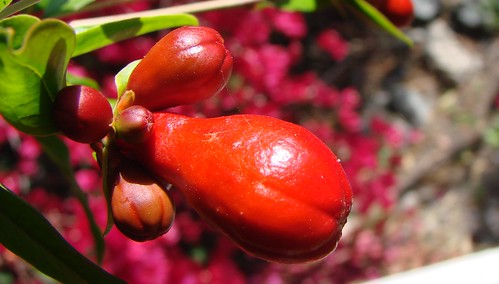
The photo above is of a pomegranate flower bud, about to open, taken in Southern California. The color is natural. The largest bud in the photo was about 2 inches/7 cm long. The photo is a live link to our Flickr photos.
Based on the Bible, pomegranates must have been important in the culture of the Middle East.
Exodus 28 and 39 say that the garment worn by the priest was to be decorated with blue, purple and scarlet pomegranates, made of yarn.
When the spies came back from Israel to Moses and the people, they brought samples of the fruit of the land, including pomegranates.
To the ancient Israelites, and to God, one of the signs that a land was good was that it was able to grow pomegranates. (Deuteronomy 8) In the desert, they complained to Moses that they would rather have stayed in Egypt, because there were no pomegranates in the desert. (Numbers 20)
Solomon's temple had bronze pillars, decorated with pomegranates. (I Kings 7)
The Song of Solomon, that great poem to erotic love, describes a beautiful woman's cheeks as being like the halves of a pomegranate.
Here's a photo of a more mature pomegranate fruit. Here's the Wikipedia article on pomegranates.
Thanks for reading!


1 comment:
Post a Comment